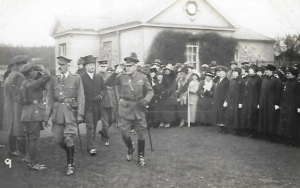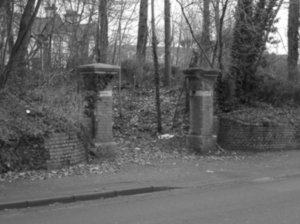For more than three decades David Thomson was the Medical Superintendent at the Norfolk Mental Hospital in Thorpe St Andrew. He was responsible for major improvements and oversaw a massive increase in the number of patients accommodated there. During the First World War he was responsible for the conversion of the site into a military hospital of which he was appointed the commanding officer.

Born in Edinburgh in 1846, Thomson was educated at the university there and in France and Germany. In 1881 he was awarded a research doctorate in medicine and specialised in the treatment of mental illness. After serving as a house surgeon at the Edinburgh Royal Infirmary he worked in mental hospitals in Derby and in London. In December 1886 he was appointed as the Medical Superintendent at the Norfolk Mental Hospital, which had 690 patients, He took up the post the following February, succeeding the much-respected Dr William Hills who had retired. That same year he married Melina Louisa Stromeyer, the daughter of a London metal merchant at Twickenham – the marriage produced a son and a daughter.
It proved to be an inspired appointment. During his time at Thorpe, he oversaw a series of major improvements and alterations and saw the number of patients increase to about 1,000. Among the improvements were the extension of the patient accommodation on the north site, (then known as the annexe), the expansion of the laundry block, a nurse’s home, an isolation block and recreation hall, the installation of electric lighting, a mortuary chapel and the provision of a new cemetery. A cricket pitch was provided on the north site – it would be a well-used sporting facility for many years and give employment to patients as grounds men. Thomson was also responsible for the construction of a new road that ran from opposite the entrance to the main hospital on the Yarmouth Road to the annexe and the cricket pitch. Constructed by the patients it took three years to complete. New staff accommodation was built or acquired – by the end of Thomson’s time at the hospital there were about 50 staff cottages within the grounds.
Thomson had a great enthusiasm for music and Gilbert and Sullivan in particular. He produced and directed several concerts featuring their works, including ‘The Mikado’, ’Utopia Limited’, The ‘Gondoliers’ and the ‘Pirates of Penzance’. They were mainly put on at the hospital for the entertainment of the patients, but local dignitaries were also invited. In April 1906 he took over the Theatre Royal in Norwich for a week to put on a production of ‘Utopia Limited’. This featured Charles Fox, the head attendant at the hospital, who appeared as King Paramount and sang and danced. Aside from his duties at the mental hospital Fox was a celebrated local entertainer – he is featured in the Thorpe History Group publication ‘Thorpe People’.
In 1892 Thomson had a house built on Yarmouth Road, known as ‘Thorpe End’, within the hospital grounds, where he lived with Melina and their children until he retired. It stood on the north side of Yarmouth Road, opposite the entrance to Boundary Lane but was demolished in the 1990s. All that remains are the gate posts inscribed with the name ‘Thorpe End’.
In February 1915, with the First World War underway and casualties mounting, the hospital was taken over by the War Office for use as a military hospital. Thomson was appointed as the commanding officer and given the rank of Lieutenant Colonel. It was a huge challenge but one he rose to. During 12 days in March, 960 patients were transferred by train to Ipswich, Melton Constable, Colchester, Brentwood, Aylesbury, St Albans, Arlesey, Goodmayes and Cambridge. It proved to be a traumatic experience for some of the patients as Thomson later recounted ‘To many the Asylum had been their home for many years, some for over fifty years, some since childhood. Many even had never been in a railway train…the whole gamut of emotions was exhibited by the patients on leaving, ranging from acute distress and misery, through gay indifference, to maniacal fury and indignation.’ The conversion to a military hospital turned out to be more complex than envisaged but, by June 1915, at a cost of about £16,000, there were 1,000 beds ready. These were soon filled as trains arrived at Norwich almost daily and the injured were ferried by ambulance to Thorpe. However, within a year, as casualty figures increased exponentially the need for more beds became pressing. Thomson advised that the existing physical and administrative structure could cope with a further 1,000 beds. Designed by the hospital architect 10 large huts were built, each capable of accommodating 60 patients; four were erected on the south site and six on the north site. Later in the war, as casualties from the German spring offensive of 1918 began arriving, a hospital camp to accommodate a further 500 beds were put up. This brought the total number of to 2428 beds.
After the war, in a report to the hospital’s board of governors, Thomson recorded that more than 40,000 casualties from the base hospitals in France and Belgium had been treated. Most had suffered from gunshot wounds. The fatality rate was about 9%, exacerbated by the influenza epidemic that contributed to so many deaths worldwide at the end of the war. Managing the Thorpe war hospital was only part of Thomson’s responsibilities during this period. In October 1915 he was asked to take military control of the auxiliary hospitals in Norfolk. They were for convalescing patients from war hospitals such as Thorpe. There were 60 hospitals with 1,907 beds in all, and Thomson became responsible for their management, including the supply of clothing from Thorpe and keeping the financial records.
The hospital was returned to its pre-war role in May 1919 and Thomson returned to his former post as the Medical Superintendent. He was honoured for his war service by being made a Commander of the Order of the British Empire (CBE) and permitted to retain his honorary rank of Lieutenant Colonel in the Royal Army Medical Corps (RAMC). He retired in early 1923 after 35 years at the hospital, and he and Melina moved to Mount Pleasant in Norwich. Sadly, his retirement proved short lived as it was marred by ill health and he died at his son-in-law’s house at Lingwood in January 1923. He was 66.

This article was inspired by a comment from local resident Alan Clark about the gateway to ‘Thorpe End’ which raised my interest. My research revealed a fascinating story about a remarkable man who not only proved to be a worthy successor to Dr Hills as the Medical Superintendent at the Norfolk Mental Hospital here in Thorpe but for four years managed the county’s largest war hospital, treating over 40,000 casualties. I am grateful to Dale Wiseman for permission to use the photograph of Thomson from his collection.
Nick Williams, Thorpe History Group






